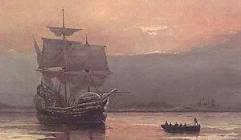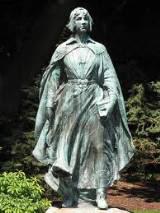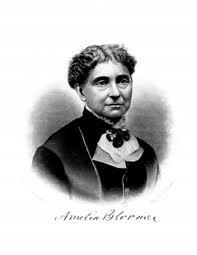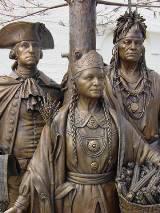Poet and Novelist in the Civil War Era Alice Cary (1820-1871) was a poet and author, and the sister of poet Phoebe Cary (1824–1871), who would become Alice’s lifelong companion. Alice Cary’s strong desire to be independent and to forge her own literary career prompted her to move alone to New York City at age 30. Cary was a most unusual 19th century woman who earned her own money, owned her own home and ran her own life – a true pioneer on many levels. A prolific writer, she ruined her health by the constant need to express herself. Alice Cary was born on April 26, 1820 on a farm in Hamilton County, Ohio, eight miles north of Cincinnati. This…
Louisa Lane
Stage Actress and Theater Manager Louisa Lane (1820-1897) was an actress and theater manager of British birth, who commanded great respect as the first female manager of a major American theater. Known for her skill as a character actor and comedian, Louisa Lane was a stage star who ultimately became the matriarch of one of the greatest acting families of all time: the Barrymores. Her legacy lives on in her descendants, including her great-great-granddaughter Drew Barrymore. Louisa Lane was born January 10, 1820 in London, England, the daughter of actress and singer Eliza Trenter and actor and stage manager Thomas Frederick Lane. Her father died during her infancy, and Louisa’s first experience on the stage occurred when she was only…

The Mayflower
Women on the Mayflower Image: The Ship Mayflower in Plymouth Harbor By William Halsall The passengers on the ship Mayflower were the earliest permanent European settlers in New England. They were referred to as the “First Comers” and they lived in perilous times. With their religion oppressed by the British government and the Church of England, the small party of Separatists who comprised almost half of the passengers on the ship sought a life where they could practice their religion freely. Freedom We Seek On September 6, 1620, the ship Mayflower set off from Plymouth, England on its journey to the New World. There were 102 passengers, which included 41 English Separatists (who would become known as the Pilgrims), who…

The Pilgrims
Pilgrim Women at Plymouth Colony The Pilgrim Maiden Statue Sculpted by Henry Hudson Kitson Brewster Gardens, Plymouth, Massachusetts Dedicated in 1924 to “those intrepid English women whose courage, fortitude and devotion brought a new nation into being.” In the first years of the 17th century, small numbers of English Puritans broke away from the Church of England and committed themselves to a life based on the Bible. Most of these Separatists were farmers, poorly educated and without social or political standing. The Separatists were persecuted in England, and many fled to Holland where their religious views were tolerated. They remained there for almost 12 years.

Amelia Bloomer
Feminist, Suffragist, Newspaper Publisher and Social Reformer Amelia Bloomer (1818–1894) was a feminist, social reformer and women’s rights activist. Amelia Bloomer owned, edited and published the first newspaper for women, The Lily, in which she promoted abolition, temperance, women’s suffrage, higher education for women and marriage law reform. Although she did not create the women’s clothing style known as Bloomers, her name became associated with it because of her early and strong advocacy. Early Years Amelia Jenks was born May 27, 1818 into a family of modest means in Homer, New York. Although she received only a few years of formal schooling, Amelia was thought to be remarkably intelligent by her peers. She became a teacher, at first in the…
Sophia Hawthorne
Writer, Artist and Wife of Author Nathaniel Hawthorne Sophia Hawthorne (September 21, 1809 – February 26, 1871) was a writer and painter, and one of the famous Peabody sisters. She took up drawing and painting in 1829, and was an accomplished artist before her marriage to author Nathaniel Hawthorne. Sophia also published her journals and some of Nathaniel’s notebooks, which she edited and published after his death. Sophia Amelia Peabody was born September 21, 1809, in Salem, Massachusetts. Her father was dentist Nathaniel Peabody and her mother was the strong Unitarian Eliza Palmer Peabody. She had three brothers; her sisters were Elizabeth Palmer Peabody and Mary Tyler Peabody (later wife of Horace Mann). With a father who had originally…

Anna Claypoole Peale
Women in Art: Early 19th Century Portrait Artist Image: Anna Claypoole Peale, 1812 Painted by her father James Peale Anna Claypoole Peale (1791–1878) was an American painter, specializing in portrait miniatures and still lifes. She was most famous for her strong characterizations of famous men. Peale was among the country’s first professional women artists, and pursued a career that propelled her into the public realm and beyond the typical domestic confines of women’s lives in the 19th century. Early Years Anna Claypoole Peale was born March 6, 1791 into an artistic family in Philadelphia, Pennsylvania. She was one of six children (all but one of them girls) of Mary Chambers Claypoole and painter James Peale, and the niece of Charles…
Helen Hunt Jackson
First Woman Commissoner of Indian Affairs Helen Hunt Jackson (1830–1885) was a poet, novelist and essayist who became an advocate for Native American rights, fighting for improved treatment of Natives by the US government. She detailed the adverse effects of previous actions taken against Indian tribes in her history A Century of Dishonor (1881). Her novel Ramona dramatized the in Southern California and attracted considerable attention to her cause. Helen Maria Fiske was born October 18, 1830 in Amherst, Massachusetts, the daughter of Nathan Welby Fiske and Deborah Vinal Fiske, a writer. Nathan Fiske was professor of Language and Philosophy at Amherst College. Helen had a sister Anne and two brothers, both of whom died soon after birth. Deborah Fiske…

Polly Cooper
Oneida Woman Who Saved Washington’s Army Polly Cooper was an Oneida woman who took part in an expedition to aid the Continental Army during the American Revolution at Valley Forge, Pennsylvania during the bitterly cold winter of 1777-78. Cooper has long been held up as an example of the courage, generosity and indomitable spirit of the Oneida people. Image: George Washington, Polly Cooper and Chief Skenandoah at the National Museum of the American Indian in Washington, DC When the Revolution began, the Oneidas decided to fight side by side with the Americans, thus becoming the young country’s first ally. In the summer of 1777, a pary of Oneidas fought at the Battle of Oriskany, a significant engagement in the Saratoga…
Isabella Beecher Hooker
19th Century Women’s Rights Leader Isabella Beecher Hooker (1822–1907) was prominent in the movement to secure equal rights for women. She was a leader, lecturer and activist for women’s suffrage (the right to vote) who refused to succumb to society’s standards of what a woman’s role should be. When she discovered that a married woman had no legal rights independent of her husband, Hooker dedicated her life’s work to the empowerment of women. Early Years Isabella Holmes Beecher was born February 22, 1822 in Litchfield, Connecticut, the second child of the prominent family of Harriet Porter and the Reverend Lyman Beecher. As her father was called to new congregations, Isabella and her family followed him to Boston, and then Cincinnati….